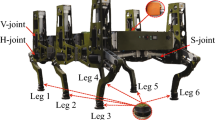Abstract
Biological inspiration has spawned a wealth of solutions to both mechanical design and control schemes in the efforts to develop agile legged machines. This paper presents a compliant leg mechanism for a small six-legged robot, HITCR-II, based on abstracted anatomy from insect legs. Kinematic structure, relative proportion of leg segment lengths and actuation system were analyzed in consideration of anatomical structure as well as muscle system of insect legs and desired mobility. A spring based passive compliance mechanism inspired by musculoskeletal structures of biological systems was integrated into distal segment of the leg to soften foot impact on touchdown. In addition, an efficient locomotion planner capable of generating natural movements for the legs during swing phase was proposed. The problem of leg swing was formulated as an optimal control procedure that satisfies a series of locomotion task terms while minimizing a biologically-based objective function, which was solved by a Gauss Pseudospectral Method (GPM) based numerical technique. We applied this swing generation algorithm to both a simulation platform and a robot prototype. Results show that the proposed leg structure and swing planner are able to successfully perform effective swing movements on rugged terrains.
Similar content being viewed by others
References
Mahardika N, Viet N Q, Park H C. Effect of outer wing separation on lift and thrust generation in a flapping wing system. Bioinspiration & Biomimetics, 2011, 6, 036006.
Viet N Q, Park H C. Design and demonstration of a locust-like jumping mechanism for small-scale robots. Journal of Bionic Engineering, 2012, 9, 271–281.
Zhang W P, Hu T J, Chen J, Shen L C. BioDKM: Bio-inspired domain knowledge modeling method for hu-manoid delivery robots planning’. Expert Systems with Applications, 2012, 39, 663–672.
Dai Z D, Sun J R. A biomimetic study of discontinuous-constraint metamorphic mechanism for gecko-like robot. Journal of Bionic Engineering, 2007, 4, 91–95.
Li H K, Dai Z D, Shi A J, Zhang H, Sun J R. Angular observation of joints of geckos moving on horizontal and vertical surfaces. Chinese Science Bulletin, 2009, 54, 592–598.
Ren L, Jones R K, Howard D. Predictive modeling of human walking over a complete gait cycle. Journal of Biomechan-ics, 2007, 40, 1567–1574.
Liu A, Howard D. Kinematic design of crab-like legged vehicles. Robotica, 2001, 19, 67–77.
Li Y, Ahmed A, Sameoto D, Menon C. Abigaille II: Toward the development of a spider-inspired climbing robot. Robotica, 2012, 30, 79–89.
Görner M, Wimböck T, Hirzinger G. The DLR crawler: Evaluation of gaits and control of an actively compliant six-legged walking robot. Industrial Robot: An International Journal, 2009, 36, 344–351.
Lewinger W A, Quinn R D. Neurobiologically-based control system for an adaptively walking hexapod. Industrial Robot: An International Journal, 2011, 38, 258–263.
Klaassen B, Linnemann R, Spenneberg D, Kirchner F. Biomimetic walking robot SCORPION: Control and modeling. Robotics and Autonomous Systems, 2002, 41, 69–76.
Erden M S. Optimal protraction of a biologically inspired robot leg. Journal of Intelligent & Robotic Systems, 2011, 64, 301–322.
Gullan P J, Cranston P S. The Insects: An Outline of Entomology, 3nd ed, Wiley-Blackwell, Oxford, USA, 2005, 21–84.
Full R J, Ahn A N. Static forces and moments generated in the insect leg: Comparison of a three-dimensional mus-culo-skeletal computer model with experimental measurements. Journal of Experimental Biology, 1995, 198, 1285–1298.
Kukillaya R P, Holmes P J. A hexapedal jointed-leg model for insect locomotion in the horizontal plane. Biological Cybernetics, 2007, 97, 379–395.
Zhao J, Zhang H, Liu Y B, Yan J H, Zang X Z, Zhou Z W. Development of the hexapod robot HITCR-II for walking on unstructured terrain. Proceedings of 2012 IEEE International Conference on Mechatronics and Automation, Chengdu, China, 2012, 14, 64–69.
Sponberg S. Neuromechanical response of musculo-skeletal structures in cockroaches during rapid running on rough terrain. Journal of Experimental Biology, 2008, 211, 433–446.
Full R J, Kubow T, Schmitt J, Holmes P, Koditschek D. Quantifying dynamic stability and maneuverability in legged locomotion. Integrative and Comparative Biology, 2002, 42, 149–157.
Alexander R M. Energy-saving mechanisms in walking and running. Journal of Experimental Biology, 1991, 160, 55–69.
Huang J J, Ge S R, Cao W. Kinematic analysis of single leg for bionic ant mine disaster relief robot. Coal Mine Machinery, 2008, 1, 83–84.
Shen T L. Robust Control of Robot, Tsinghua University Press, Beijing, China, 2000. (in Chinese)
Alexander R M N. Optima for Animals, Princeton University Press, Princeton, USA, 1996.
Alexander R M N. Principles of Animal Locomotion, Princeton University Press, Princeton, USA, 2002.
Kyriakopoulos K J, Saridis G N. Minimum jerk path generation. Proceedings of 1988 IEEE International Conference on Robotics and Automation, Philadelphia, USA, 1988, 14, 364–369.
Flash T, Hogan N. The coordination of arm movements: an experimentally confirmed mathematical model. The Journal of Neuroscience, 1985, 5, 1688–1703.
Simon D. The application of neural networks to optimal robot trajectory planning. Robotics and Autonomous Systems, 1993, 11, 23–24.
Huntington G T. Advancement and Analysis of a Gauss Pseudospectral Transcription for Optimal Control Problems, PhD Thesis, Massachusetts Institute of Technology, USA, 2007.
Wang J, Gao F, Zhang Y. Adaptive compliance control of a hydraulic manipulator in free forging. Proceedings of the Institution of Mechanical Engineers, Part B: Journal of Engineering Manufacture, 2012, 226, 279–289.
Author information
Authors and Affiliations
Corresponding author
Rights and permissions
About this article
Cite this article
Chen, J., Liu, Y., Zhao, J. et al. Biomimetic Design and Optimal Swing of a Hexapod Robot Leg. J Bionic Eng 11, 26–35 (2014). https://doi.org/10.1016/S1672-6529(14)60017-2
Published:
Issue Date:
DOI: https://doi.org/10.1016/S1672-6529(14)60017-2




